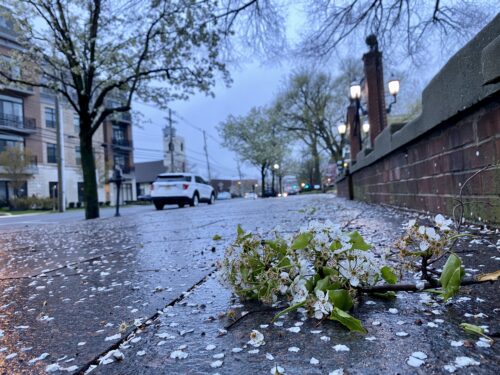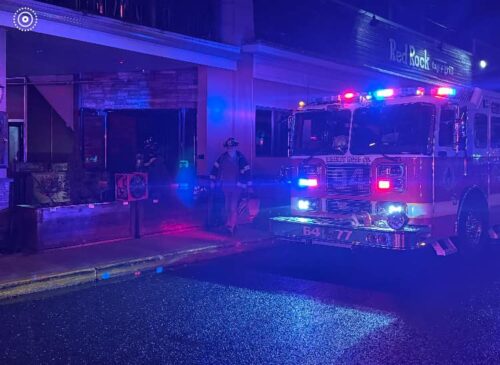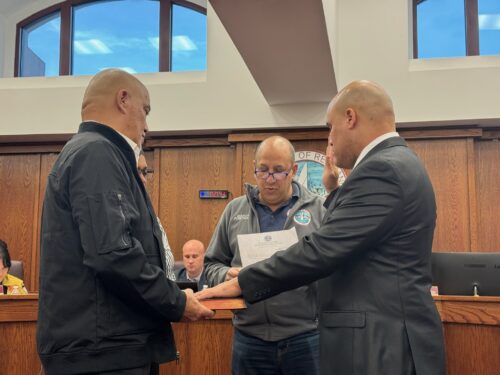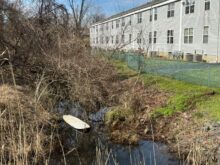
By JOHN T. WARD
A dispute between neighboring property owners over the removal of trees from a Rumson building site took on the air of a trial Monday night.
But the planning board wrapped up a three-hour hearing without a verdict… er, decision… on whether borough officials allowed builder John Tsakiris to get away with a wholesale tree “murder,” as alleged by neighbors Rick Jones and Cindy Zipf.

The case is an appeal by Jones and Zipf, who founded and heads Sandy Hook-based Clean Ocean Action, of a tree-removal permit issued by Frederick André, the boroughs tree conservation officer, to Tsakiris’ company, Petcon Builders.
Zipf and Jones contend Tskairis clear-cut the property, exceeding the limits of both the permit and the town’s tree-preservation ordinance.
The result, they say, is repeated and unprecedented flooding of their yard, at 37 Navesink Avenue.
Jones produced a sheaf of color photos showing muddy brown water overtopping a silt-control fence separating the two properties and inundating his with more than a foot of water for days. He’s also posted video of the runoff on YouTube.
The flooding occurred three times in August, most recently during Hurricane Irene on August 28, Jones testified. But no similar flooding had occurred on the property at least since 1978, when Zipf’s mother acquired it, he said.
“If there’s a substantial rain, there will be ponding out there for days and days,” with up to 18 inches of water. “This has never happened before.”
Jones and Zipf are represented by attorney Andrew Provence, who grilled Tsakiris, who is building a 5,000-square-foot home for an unnamed buyer, about the removal of trees.
Tsakiris acknowledged taking down more than the 23 trees covered by the permit, but said the additional ones were either exempt from the ordinance because of their size, were unsustainable, or were “dirty” trees that would not be appealing to the buyer.
“We felt there were a lot more trees that were distressed, diseased, vine-choked,” he said. “We probably should have gone back and added them to the permit, but we didn’t because many of them were below four inches” in diameter at chest height, the cut-off point below which trees are exempt from the law’s protection.
“We saved every good tree that we could,” he added.
Tsakiris dismissed Jones’ claims that the cutting had caused flooding of the Jones-Zipf yard. When asked by a board member if he agreed that the couple were suffering a hardship as a consequence of the construction, Tsakiris replied: “I don’t think it’s a hardship. I don’t believe there’s any more water going on their property now than before.”
During the questioning of his client, attorney Mark Aikens raised a number of objections, claiming at one point that Provence was badgering Tsakiris.
Several residents, however, supported Zipf and Jones and zeroed in on what they saw as a lack of protection in the law for the owners of developed properties during construction on adjoining sites.
“In 17 years, I’ve never seen any flooding issue,” said neighbor Danielle Haub-Richmond. “Now, it’s ridiculous, and it has nothing to do with the hurricane.”
“I would hope that in the spirit of the borough that the planning board consider protecting neighbors, and not just developers,” said Ann Rossbach.
Doug Spencer, of the borough Shade Tree Commission, went on the offensive against Jones, pressing him on his horticultural expertise, and Bill Brooks, the town’s former tree officer, testified that the language of the ordinance governing what trees are subject to protection is more nuanced than Zipf and Jones contend.
The hearing is scheduled to continue October 3. Meantime, Tsakiris pledged to take steps to protect the Zipf-Jones lot from future flooding, including the immediate installation of hay bales.





















